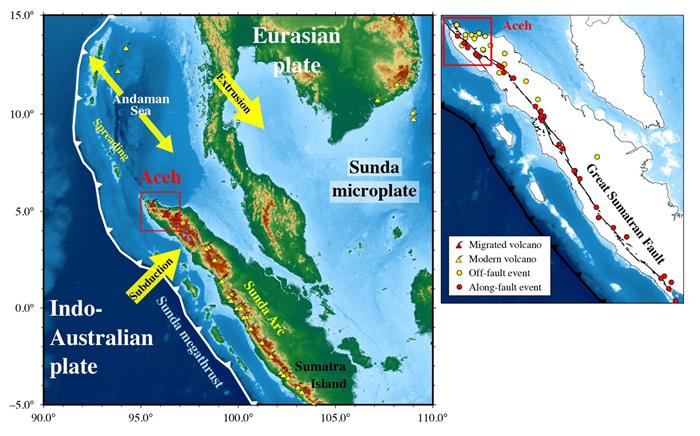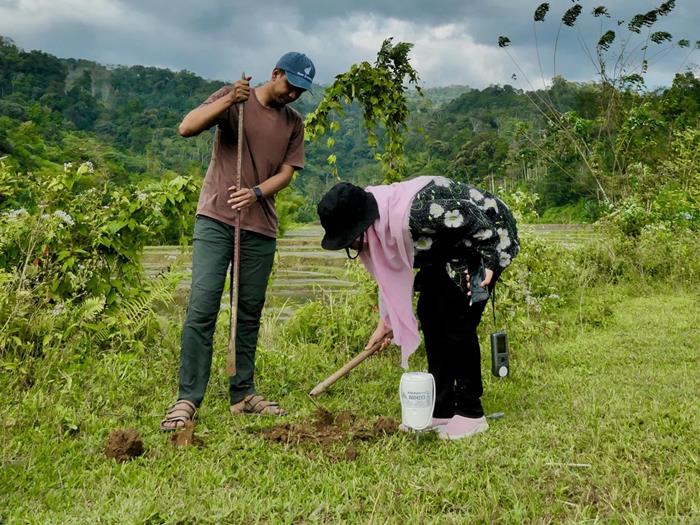Most earthquakes and volcanoes in Sumatra, Indonesia are aligned with a long fault that crosses the island, the Great Sumatran Fault. However, Aceh, located in northern Sumatra, is marked with unusual seismic and volcanic activities. Sizeable off-fault earthquakes happen more often in Aceh than in any other region in Sumatra. In addition the volcanic arc, which includes the Seulawah Agam, Peuet Sague, and Geureudong volcanoes, has unusually migrated north over time - something not observed for the rest of the island.
While it is well-known that the seismicity on the Great Sumatran Fault is related to the Sunda Megathrust, the subduction zone where the Indo-Australian Plate slides below the Sunda Plate, a team led by researchers from the Earth Observatory of Singapore (EOS) at the Nanyang Technological University, Singapore found that the unusual seismic and volcanic activities around Aceh are due to the interactions between the megathrust and other tectonic processes related to the seafloor spreading hundreds of kilometres north of Sumatra. Their findings were published in Geophysical Research Letters in November 2023.

Maps showing the different tectonic features affecting the seismic and volcanic activities in Aceh. Left: The subducting Sunda Megathrust off the west coast of Sumatra, and the spreading of the Andaman Sea north of Aceh. Right: A large strike-slip fault, the Great Sumatran Fault (GSF), runs through the entire length of Sumatra island. The red and yellow dots show historical earthquakes of magnitude greater than 5.5 along and off the GSF respectively. (Source: modified from Figure 1 from the publication).
Many scientists observed these unusual seismic and volcanic activities, but a lack of nearby seismic observations prevented a comprehensive understanding of the regional tectonic framework responsible for these anomalies. To address this gap, the scientists deployed 155 seismic nodes in Aceh over the period of 18 months, in 2020 and 2021.
The seismic nodes recorded the seismic waves generated by far-away earthquakes, called teleseismic earthquakes. These waves travel through the interior of the earth before eventually reaching the nodes, bringing valuable information about the rocks they passed through, such as how much magma is present or how thick the crust is below Sumatra.

The local deployment team included students from Syiah Kuala University, and two of them are pictured here deploying a seismic node at the farmyard in Aceh. (Source: Karen Lythgoe for Eos, AGU) (https://doi.org/10.1029/2022eo220140)
From the seismic data collected, the scientists estimated that the average fraction of melt in the crust is high - about 12% on average and up to 19% - indicating that the crust under Aceh is filled with partially molten rock or in a molten state. They also found that in some areas of northern Aceh, the crust is as thin as 22 km, which is much thinner than in global continental areas.
The high melt fractions and thin crust provide conditions favourable for volcanic activity and influenced the movement of volcanic material over time. In addition to influencing the volcanic activity around Aceh, the team proposes that the thin crust is also responsible for the unusual seismic activities at Aceh, and that it is due to the intense stretching caused by the opening of the Andaman Sea, where tectonic plates under the sea floor diverge and generate new ocean floor.
“These intriguing findings benefit from a brand-new seismological technique, called H-Φ stacking, which estimates the crustal thickness and melt fraction at the mean time and with higher accuracy,” said Dr Mingye Feng, the first author of the paper who recently joined EOS as a Research Fellow under the Integrating Volcano and Earthquake Science and Technology (InVEST) programme, an ambitious interdisciplinary programme that explores interconnections between earthquakes and volcanic eruptions in Southeast Asia, and their impacts on local communities. “These findings improve our understanding of the tectonic framework in northern Sumatra and its relations with the regional volcanic and seismic activities,” said Associate Professor Wei, a co-author on the study who leads a component of the InVEST programme.
This study focuses on north Aceh, but it highlights the need to better understand the different active zones across Southeast Asia. Such research is crucial for enhancing our preparedness for volcanic and earthquake hazards in the region.
This research is supported by the Ministry of Education, Singapore, under its MOE AcRF Tier 3 Award MOE-MOET32021-000 (Component D).